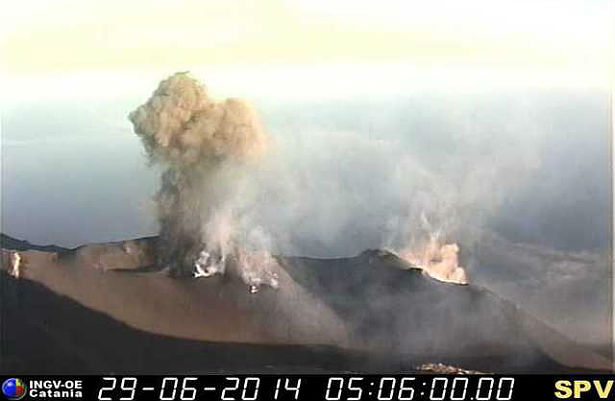Elevated activity continues at Stromboli volcano, Italy

A sharp increase in Strombolian activity was observed from all of the craters of Stromboli volcano, Eolian Islands – Italy, on June 22, 2014. The activity still remains elevated.
A high level of magma causes continuous spattering and many strombolian eruptions from several vents on the crater terrace.
During the week of June 18 – 24, 2014, INGV reported two episodes of effusive activity at Stromboli, one on June 17 and another on June 22.
Activity on 17 June occurred in the morning within the central part of the crater terrace (Bocca S2) and included explosive spattering. This activity lasted for a few hours and produced a small lava flow directed toward Pizzo Sopra la Fossa.
A sharp increase in Strombolian activity began from all of the craters on June 22, depositing voluminous material along the Sciara del Fuoco. A lava flow ~200 m long extended from the mouth of N2 (within the N part of the crater terrace). During the evening this flow slowed, and then stalled the following day when Strombolian activity decreased.
Geological summary
Spectacular incandescent nighttime explosions at Stromboli volcano have long attracted visitors to the “Lighthouse of the Mediterranean.” Stromboli, the NE-most of the Aeolian Islands, has lent its name to the frequent mild explosive activity that has characterized its eruptions throughout much of historical time. The small, 924-m-high island of Stromboli is the emergent summit of a volcano that grew in two main eruptive cycles, the last of which formed the western portion of the island.
The Neostromboli eruptive period from about 13,000 to 5000 years ago was followed by formation of the modern Stromboli edifice. The active summit vents are located at the head of the Sciara del Fuoco, a prominent horseshoe-shaped scarp formed about 5000 years ago as a result of the most recent of a series of slope failures that extend to below sea level. The modern volcano has been constructed within this scarp, which funnels pyroclastic ejecta and lava flows to the NW. Essentially continuous mild strombolian explosions, sometimes accompanied by lava flows, have been recorded at Stromboli for more than a millennium. (GVP)
Featured image: Webcam image of eruption at 05:09 UTC on June 29, 2014 (Credit: INGV Catania)

Commenting rules and guidelines
We value the thoughts and opinions of our readers and welcome healthy discussions on our website. In order to maintain a respectful and positive community, we ask that all commenters follow these rules:
We reserve the right to remove any comments that violate these rules. By commenting on our website, you agree to abide by these guidelines. Thank you for helping to create a positive and welcoming environment for all.